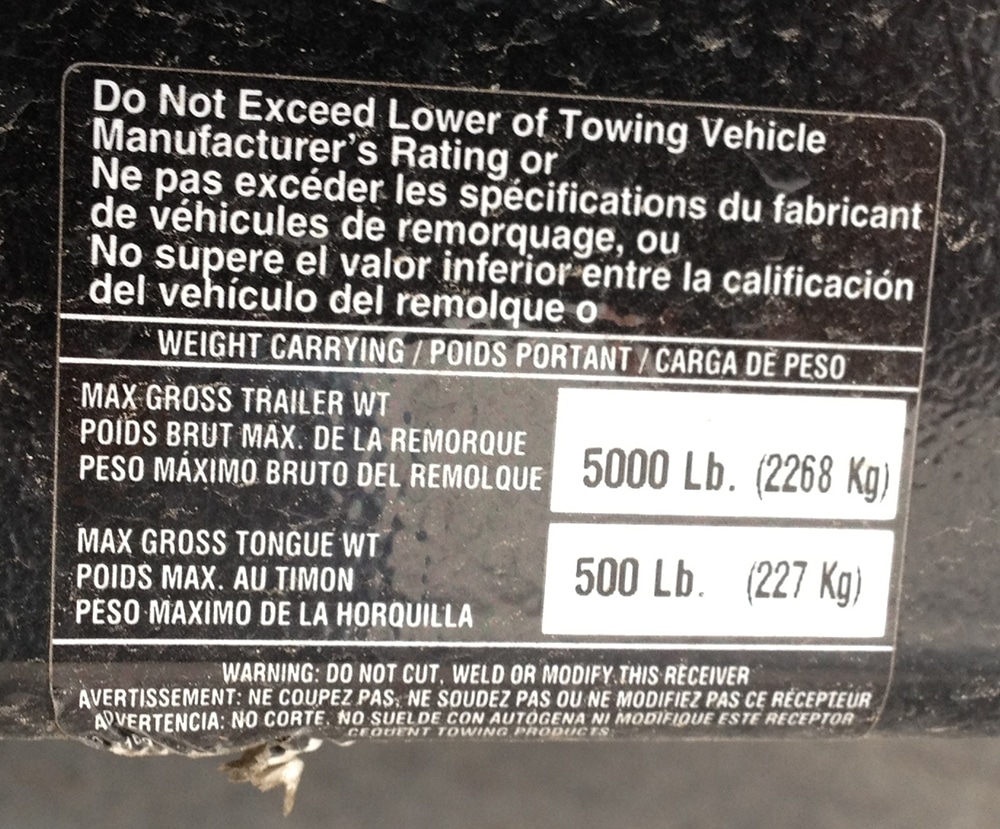What is a Trailer Tow Hitch Towing and Tongue Weight Capacity Rating Sticker Label and Where is it on My Car?
In order to tow a trailer with your vehicle, you will need to learn its general towing and tongue weight capacities first. In order to do this accurately, you will need to refer to your vehicle’s compliance certification label or trailer tow hitch weight rating label. This label will have much of the information you need to calculate all the numbers necessary for safe towing, including your tongue weight, towing capacity, vehicle weight, and more.
But before you go looking for your vehicle’s compliance certification label, you must first check your owners’ manual to see if your vehicle is capable of towing. Once you are sure your vehicle can tow a trailer, you are ready to refer to your vehicle’s compliance certification label. Continue reading to learn what is on this label and where is it located on a car.
Compliance Certification Labels
You can typically find a tow hitch towing and tongue weight rating label sticker on the inside of your driver’s side car door jam or on the tow hitch receiver on the back of your vehicle.

Vehicle Towing Capacity
How much weight a vehicle can pull can vary hugely, even between two pickups that look identical. That’s why finding out your towing capacity on your tow hitch or by VIN is more accurate. Factors that can affect a vehicle towing capability include:
- Engine Type
- Axle Ratios
- Transmissions
- Chassis
- Suspension
- Tires and load ratings
- Hitch type and class
- Trailer type
Towing Hitch Capacity Formula
- Find out curb weight on your tow hitch (or on VIN sticker).
- Add the weight of passengers, fuel, and cargo to the curb weight.
- Subtract this number from your vehicle’s GCWR ( you may have to look this up using your VIN if it’s not on the door sticker).
- This is your max towing capacity.
- Check to make sure the hitch can also handle this weight.
Tongue Weight Hitch Capacity Formula
Tongue weight is the amount of weight a trailer puts on the towing vehicle’s tow hitch receiver or trailer ball. This is important for customers who use motorcycle hitch carriers, tow hitch cargo luggage baskets carriers, and mobility scooter or wheelchair hitch carrier with loading ramp.
In many cases, the maximum allowable tongue weight is between 10% and 15% of the maximum allowable towing weight, which includes the weight of the trailer or hitch carriers itself plus the load it’s carrying. That tongue weight capacity is typically dictated by either the manufacturer of the vehicle or by the manufacturer of the trailer-hitch receiver. A good rule of thumb is to use 10% if you cant find the tongue weight capacity sticker.
For example, if the maximum allowable trailer weight is 4,000 pounds, the maximum tongue weight will be 400 lb pounds. If your hitch carrier is 80 lbs and your scooter is 290 lbs then the total weight you will be loading will be 370 lbs. 400 lbs minus 370 lbs leave you with a extra allowable 30 lbs under your tongue weight limit.
Tow Hitch Abbreviations and Acronyms
There are several acronyms and numbers listed on a compliance certification label, including “GVWR”, GCW”, “GAW”, and more. All of these fields listed on the compliance certification label are pertinent to your car’s towing capacity. Keep in mind that all of these numbers are approximations, and vary depending on what you have in your car, such as occupants and luggage.
Gross Vehicle Weight (GVW) – This is how much the vehicle weighs. It is commonly referred to as its “curb” weight. This number includes allowance for occupant weight, luggage weight, fuel weight, and more, as predicted by the manufacturer.
Gross Vehicle Weight Rating (GVWR) – This is the maximum weight that is considered safe for your vehicle, as determined by manufacturer. Exceeding this weight can jeopardize the transmission, engine, brakes, and more.
Gross Combination Weight (GCW) – This number has to do with your trailer. It is the total weight of your vehicle and your trailer combined. But this does not include the trailers tongue weight.
Gross Combination Weight Rating (GCWR) – This number is the maximum weight that is considered safe for your vehicle and trailer combined. This includes people, luggage, cargo, and more.
Gross Axel Weight (GAW) – These numbers are the weights predicted to be placed on your vehicle’s front and rear axles. Because of engines and other factors, it is likely for these numbers to differ from one another.
Gross Axel Weight Rating (GAWR) – this number is the maximum weight is considered safe to place on your front and rear axles. Exceeding this weight can be highly detrimental to your vehicle and trailer.

